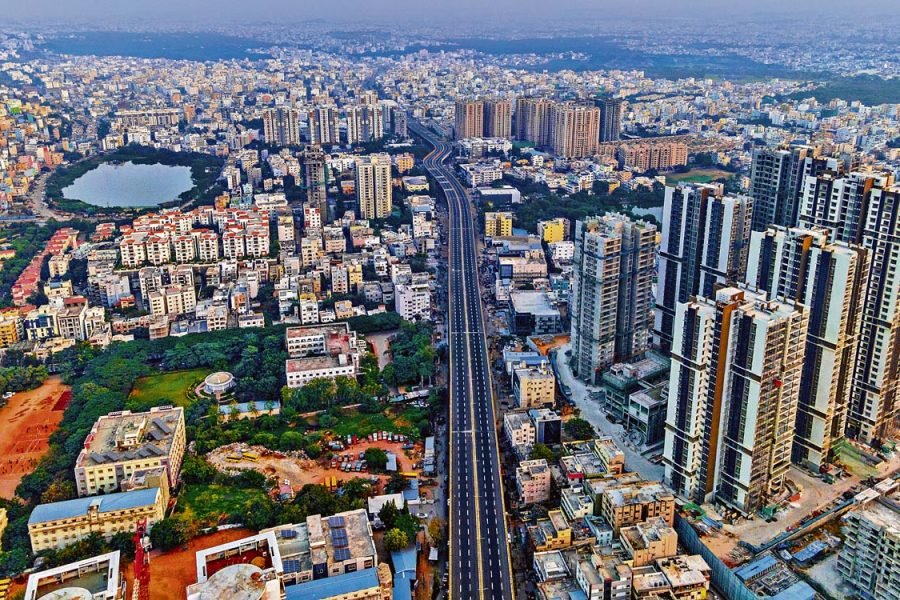If you’ve lived in Hyderabad for over a decade, you’ve probably seen the shift for yourself. The skyline looks different. The suburbs are busier. And areas once considered “too far out” are now packed with families, offices, and cafes.
This isn’t just routine growth, it’s a carefully unfolding shift that’s turning Hyderabad into one of India’s most sought-after real estate markets. And as we look ahead, all signs point to one conclusion: Hyderabad real estate in 2030 is headed for a solid, sustainable boom.
Here are 15 factors – real reasons behind that momentum.
1. A City That Plans Ahead
Hyderabad doesn’t just grow; it prepares. The Outer Ring Road (ORR) is a prime example of that. Now, the focus is on the Regional Ring Road (RRR), which will bring more remote areas into the urban fold. This kind of planning makes expansion smoother, not chaotic.
2. Jobs That Stay Local
Let’s be honest, jobs are the biggest reason people move. With tech companies expanding in places like Gachibowli and Nanakramguda, thousands of professionals are choosing to settle down nearby. It’s no longer about just renting. Buying has become part of the plan.
3. New Localities Taking Off
Ten years ago, you wouldn’t have thought of Kollur, Shamirpet, or Mokila as serious residential zones. But with roads, schools, and amenities improving, these areas are now attracting both first-time buyers and investors looking for long-term appreciation.
The real estate growth in Hyderabad is no longer limited to West Hyderabad. It’s moving in all directions — and that’s what makes it sustainable.
4. Biotech and Pharma Fueling the North
While IT dominates the west, biotech and life sciences are making the North stronger. Genome Valley and Pharma City are creating jobs, and wherever jobs go, residential demand follows.
5. Property Still Affordable Compared to Other Metros
Buying a decent 2 BHK in Bengaluru’s Whitefield or Mumbai’s suburbs can feel like a stretch for most working professionals. In Hyderabad, that same budget still gets you a better layout, more space, and often, a gated community. This affordability is key to the future of Hyderabad real estate.
6. A Smoother Buying Process
The TS-bPASS system and other pro-developer policies have made the approval process quicker. Buyers now get clearer documentation, and developers can bring projects to market faster. That means less delay and fewer hidden surprises.
7. The Metro is Growing – And So Are Prices Along the Route
We’ve already seen how the metro improved connectivity from LB Nagar to Miyapur. The new lines, especially the one toward the airport — will unlock value in areas like Uppal, Nagole, and Rajendranagar.
8. Cleaner Air, Better Roads (Still)
Hyderabad hasn’t escaped urban issues but it still ranks better than many Indian metros in terms of pollution, traffic, and civic upkeep. For families relocating from other cities, this often tips the scale.
9. NRIs Choosing Hyderabad Over Bengaluru and Chennai
This one’s a trend few saw coming. NRIs, especially those from the US and Gulf countries, are showing more confidence in Hyderabad’s real estate than in other southern cities. The reasons? Better infrastructure, smoother transactions, and personal familiarity with the city.
10. Education and Healthcare Driving Local Demand
Good schools, medical colleges, and multi-speciality hospitals are spreading out across the city. With facilities like AIIMS, Continental Hospital, and international schools setting up outside city limits, people are more open to living in newer zones increasing localised housing demand.
11. Gated Communities Becoming the Norm
Buyers now ask for more than just square footage. They want play areas, walking tracks, parking, and security. Builders are responding by developing gated layouts not just in luxury zones, but also in mid-tier markets. This demand shift is changing how projects are designed.
12. Rentals That Actually Make Sense for Investors
In zones near tech parks and industrial clusters, rental yields are steady, not skyrocketing, but not flat either. 2BHKs in Kondapur or Madinaguda, for example, see quick occupancy and low downtime. For investors looking at 2030, these rental flows build long-term value.
13. Real Estate Becoming Part of Long-Term Financial Planning
For many middle-class and upper-middle-class families in Hyderabad, property isn’t just about living. It’s about building future wealth. Parents are investing in plots or second homes for their children, seeing real estate as a safer, more tangible form of savings.
14. High-Rise and Luxury Living Are Growing – Organically
Unlike Mumbai where people are forced into vertical living, Hyderabad’s luxury apartments and villas are growing by choice. Projects in Kokapet, Narsingi, and Puppalaguda now come with skyline views, branded fittings, and full clubhouses — and buyers are willing to pay for it.
15. Word of Mouth and Reputation
When someone’s uncle buys a flat in Adibatla and sees appreciation in three years, the whole family takes notice. This word-of-mouth growth has a powerful effect in cities like Hyderabad. People trust personal experience more than marketing and that’s fueling the market further.
A Glimpse at 2030
What makes Hyderabad’s real estate different is that it isn’t growing just for the sake of it. The city is expanding, yes but in a way that feels planned and purposeful. Roads connect better. Workplaces and homes are closer than they were a decade ago. And families today are looking at places that weren’t even on their radar five years back.
Looking at the pace of development and the way people are choosing to live, it’s clear that the coming years will belong to those who take informed steps now. 2030 isn’t far away and those who make their move today are likely to benefit the most from the shift that’s already begun.
If you’re exploring the market but unsure where to start, consider speaking with the team at Anokhi Homes. They’ve spent years understanding how Hyderabad’s localities grow, what buyers really look for, and where real value lies. Sometimes, having the right guidance is the difference between buying fast and buying right.

